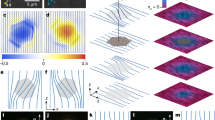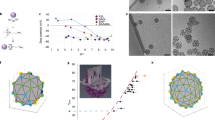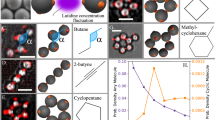Abstract
Smoke, fog, jelly, paints, milk and shaving cream are common everyday examples of colloids1, a type of soft matter consisting of tiny particles dispersed in chemically distinct host media. Being abundant in nature, colloids also find increasingly important applications in science and technology, ranging from direct probing of kinetics in crystals and glasses2 to fabrication of third-generation quantum-dot solar cells3. Because naturally occurring colloids have a shape that is typically determined by minimization of interfacial tension (for example, during phase separation) or faceted crystal growth1, their surfaces tend to have minimum-area spherical or topologically equivalent shapes such as prisms and irregular grains (all continuously deformable—homeomorphic—to spheres). Although toroidal DNA condensates and vesicles with different numbers of handles can exist4,5,6,7 and soft matter defects can be shaped as rings8 and knots9, the role of particle topology in colloidal systems remains unexplored. Here we fabricate and study colloidal particles with different numbers of handles and genus g ranging from 1 to 5. When introduced into a nematic liquid crystal—a fluid made of rod-like molecules that spontaneously align along the so-called ‘director’10—these particles induce three-dimensional director fields and topological defects dictated by colloidal topology. Whereas electric fields, photothermal melting and laser tweezing cause transformations between configurations of particle-induced structures, three-dimensional nonlinear optical imaging reveals that topological charge is conserved and that the total charge of particle-induced defects always obeys predictions of the Gauss–Bonnet and Poincaré–Hopf index theorems11,12,13. This allows us to establish and experimentally test the procedure for assignment and summation of topological charges in three-dimensional director fields. Our findings lay the groundwork for new applications of colloids and liquid crystals that range from topological memory devices14, through new types of self-assembly15,16,17,18,19,20,21,22,23, to the experimental study of low-dimensional topology6,7,11,12,13.
This is a preview of subscription content, access via your institution
Access options
Subscribe to this journal
Receive 51 print issues and online access
$199.00 per year
only $3.90 per issue
Buy this article
- Purchase on Springer Link
- Instant access to full article PDF
Prices may be subject to local taxes which are calculated during checkout




Similar content being viewed by others
References
Hunter, R. J. Foundations of Colloid Science (Oxford Univ. Press, 2001)
Alsayed, A. M., Islam, M. F., Zhang, J., Collings, P. J. & Yodh, A. G. Premelting at defects within bulk colloidal crystals. Science 309, 1207–1210 (2005)
Semonin, O. E. et al. Peak external photocurrent quantum efficiency exceeding 100% via MEG in a quantum dot solar cell. Science 334, 1530–1533 (2011)
Hud, N. V., Downing, K. H. & Balhord, R. A constant radius of curvature model for the organization of DNA in toroidal condensates. Proc. Natl Acad. Sci. USA 92, 3581–3585 (1995)
Michalet, X. & Bensimon, D. Observation of stable shapes and conformal diffusion in genus 2 vesicles. Science 269, 666–668 (1995)
Hsu, L., Kusner, R. & Sullivan, J. Minimizing the squared mean curvature integral for surfaces in space forms. Exp. Math. 1, 191–207 (1992)
Kamien, R. D. The geometry of soft materials: a primer. Rev. Mod. Phys. 74, 953–971 (2002)
Lavrentovich, O. D. & Terentjev, E. M. Phase transition altering the symmetry of topological point defects (hedgehogs) in a nematic liquid crystal. Sov. Phys. JETP 64, 1237–1244 (1986)
Tkaleč, U., Ravnik, M., Čopar, S., Žumer, S. & Muševič, I. Reconfigurable knots and links in chiral nematic colloids. Science 33, 62–65 (2011)
Kleman, M. & Lavrentovich, O. D. Topological point defects in nematic liquid crystals. Phil. Mag. 86, 4117–4137 (2006)
Montiel, S. & Ros, A. Curves and Surfaces 2nd edn (American Mathematical Society, 2009)
Milnor, J. W. Topology from the Differentiable Viewpoint (Univ. Press of Virginia, 1965)
Hopf, H. Vektorfelder in n-dimensionalen Mannigfaltigkeiten. Math. Ann. 96, 225–249 (1927)
Araki, T., Buscaglia, M., Bellini, T. & Tanaka, H. Memory and topological frustration in nematic liquid crystals confined in porous materials. Nature Mater. 10, 303–309 (2011)
Poulin, P., Holger, S., Lubensky, T. C. & Weitz, D. A. Novel colloidal interactions in anisotropic fluids. Science 275, 1770–1773 (1997)
Irvine, W. T. M., Vitelli, V. & Chaikin, P. M. Pleats in crystal on curved surfaces. Nature 468, 947–951 (2010)
Jones, M. R. et al. DNA-nanoparticle superlattices formed from anisotropic building blocks. Nature Mater. 9, 913–917 (2010)
Lapointe, C. P., Mason, T. G. & Smalyukh, I. I. Shape-controlled colloidal interactions in nematic liquid crystals. Science 326, 1083–1086 (2009)
Sacanna, S., Irvine, W. T. M., Chaikin, P. M. & Pine, D. J. Lock and key colloids. Nature 464, 575–578 (2010)
Wood, T. A., Lintuvuori, J. S., Schofield, A. B., Marenduzzo, D. & Poon, W. C. K. A self-quenched defect glass in a colloid–nematic liquid crystal composite. Science 334, 79–83 (2011)
Poulin, P., Cabuil, V. & Weitz, D. A. Direct measurement of colloidal forces in an anisotropic solvent. Phys. Rev. Lett. 79, 4862–4865 (1997)
Tkalec, U., Ravnik, M., Žumer, S. & Muševič, I. Vortexlike topological defects in nematic colloids: chiral colloidal dimers and 2D crystals. Phys. Rev. Lett. 103, 127801 (2009)
Trivedi, R. P., Klevets, I. I., Senyuk, B., Lee, T. & Smalyukh, I. I. Multi-scale interactions and three-dimensional patterning of colloidal particles and defects in lamellar soft media. Proc. Natl Acad. Sci. USA 109, 4744–4749 (2012)
Herges, R. Topology in chemistry: designing Möbius molecules. Chem. Rev. 106, 4820–4842 (2006)
Mosseri, R. Geometrical frustration and defects in condensed matter systems. C. R. Chim. 11, 192–197 (2008)
Bowick, M. J., Chandar, L., Schiff, E. A. & Srivastava, A. M. The cosmological Kibble mechanism in the laboratory: string formation in liquid crystals. Science 263, 943–945 (1994)
Han, Y. et al. Brownian motion of an ellipsoid. Science 314, 626–630 (2006)
Solomon, M. J. Directions for targeted self-assembly of anisotropic colloids from statistical thermodynamics. Curr. Opin. Colloid Interface Sci. 16, 158–167 (2011)
Merkel, T. J. et al. Scalable, shape-specific, top-down fabrication methods for the synthesis of engineered colloidal particles. Langmuir 26, 13086–13096 (2010)
Lee, T., Trivedi, R. P. & Smalyukh, I. I. Multimodal nonlinear optical polarizing microscopy of long-range molecular order in liquid crystals. Opt. Lett. 35, 3447–3449 (2010)
Pettey, D. & Lubensky, T. C. Stability of texture and shape of circular domains of Langmuir monolayers. Phys. Rev. E Stat. Phys. Plasmas Fluids Relat. Interdiscip. Topics 59, 1834–1845 (1999)
Alexander, G. P., Chen, B. G., Matsumoto, E. A. & Kamien, R. D. Colloquium: Disclination loops, point defects, and all that in nematic liquid crystals. Rev. Mod. Phys. 84, 497–514 (2012)
Chaikin, P. M. & Lubensky, T. C. Principles of Condensed Matter Physics (Cambridge Univ. Press, 2000)
Acknowledgements
We thank P. Chen, N. Clark, J.-i. Fukuda and S. Žumer for discussions. This work was supported by the International Institute for Complex Adaptive Matter and the National Science Foundation grants DMR-0844115 (Q.L., S.H. and I.I.S.), DMR-0820579 (B.S. and I.I.S.), DMR-0847782 (B.S., Q.L. and I.I.S.), PHY11-25915 (R.D.K., R.B.K., T.C.L. and I.I.S.) and DMR-1120901 (R.D.K. and T.C.L.). R.B.K., R.D.K., T.C.L. and I.I.S. thank the Kavli Institute for Theoretical Physics for their hospitality while this work was being discussed and prepared for publication.
Author information
Authors and Affiliations
Contributions
B.S., Q.L. and I.I.S. performed experimental work. Q.L., S.H. and I.I.S. designed and fabricated particles. B.S. and I.I.S. reconstructed director fields induced by colloids. T.C.L. and I.I.S. characterized topological charges of defects in particle-induced director fields. R.B.K., R.D.K., T.C.L. and I.I.S. proposed models of field transformations satisfying topological constraints and explained the relations between genus of colloids and the net topological charge of liquid crystal defects. I.I.S. conceived the project, designed experiments, provided funding and wrote the manuscript. All authors edited and commented on the manuscript.
Corresponding author
Ethics declarations
Competing interests
The authors declare no competing financial interests.
Supplementary information
Supplementary Information
This file contains Supplementary Text and Data 1-4, Supplementary References and Supplementary Figures 1-12. (PDF 5542 kb)
Rights and permissions
About this article
Cite this article
Senyuk, B., Liu, Q., He, S. et al. Topological colloids. Nature 493, 200–205 (2013). https://doi.org/10.1038/nature11710
Received:
Accepted:
Published:
Issue Date:
DOI: https://doi.org/10.1038/nature11710
This article is cited by
-
Topology mediates transport of nanoparticles in macromolecular networks
Nature Communications (2022)
-
Active boundary layers in confined active nematics
Nature Communications (2022)
-
Tomographic measurement of dielectric tensors at optical frequency
Nature Materials (2022)
-
Isotropically resolved label-free tomographic imaging based on tomographic moulds for optical trapping
Light: Science & Applications (2021)
-
Oblique light incidence method to study topological defects in nematic layers with conical boundary conditions
Scientific Reports (2021)
Comments
By submitting a comment you agree to abide by our Terms and Community Guidelines. If you find something abusive or that does not comply with our terms or guidelines please flag it as inappropriate.



